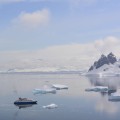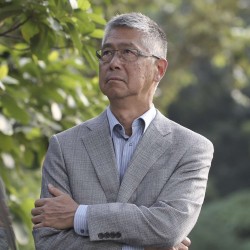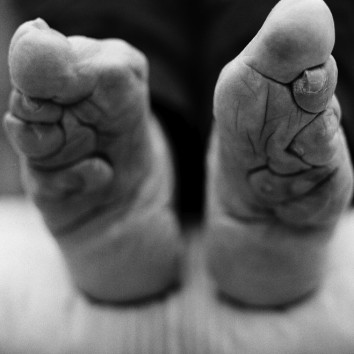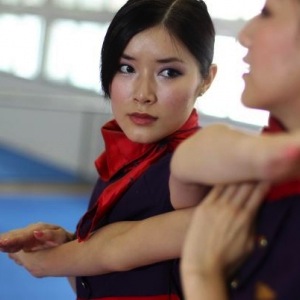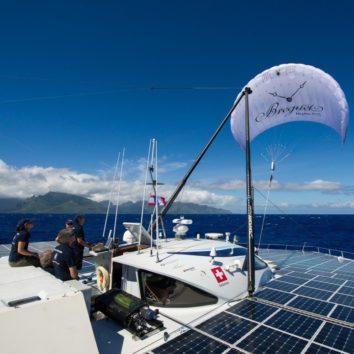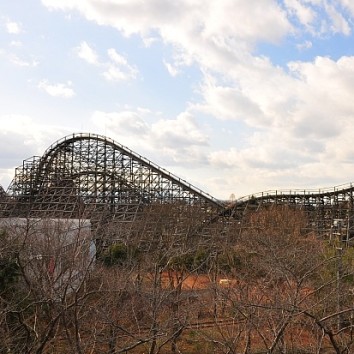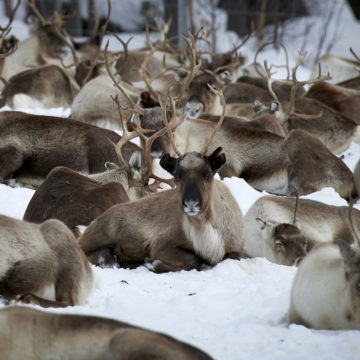
The People and the Light in the Arctic
— June 1, 2018In one of the coldest regions in the world, the Sami have survived harsh elements of nature and even state repression to continue their way of living and preserve their culture and traditions.
![]()
It’s March in the Swedish Arctic and the pine trees are still heavy with snow, great globs of whipped ice weighing down the branches. The reindeer, initially startled at the appearance of two strangers, have calmed and all is silent aside from the clicking of their hooves.
Kenneth Pittja leans against his snowmobile, keeping an eye on his herd. He’s dressed for the cold in a thick jacket and gloves, a pair of mirrored sunglasses tucked into the ridge of his hat. It’s a cool look, a Gaucho of the Arctic, and he oozes the confidence of someone who is on home turf and knows exactly who he is – he’s Sami, one of the indigenous people of northern Europe, and like his father, grandfather and the generations before that he is a reindeer herder. His son, Pavarotti, and daughter are there, too – they work alongside him.
“This winter was tough. The snow came early – there was so much snow it was hard for the animals to move around, the reindeer were almost trapped, they struggled to find food,” says Kenneth, 59.
Reindeer are herbivores and eat lichens and moss, but the cold conditions this year covered the ground in a layer of ice and then snow, making it difficult for the animal to feed, they were expending more energy digging for lichens than they got from it, so Kenneth splashed out on nutritionally balanced pellets to feed his stock.
I can’t tell you exactly how many reindeer he has because I’m warned that it’s rude to ask – like asking someone how much money they have in the bank. Of course I do ask, and Kenneth chuckles, but doesn’t reply. Nothing seems to faze him. What’s made it an even tougher winter is that the predators have been out in force.
“The other night a lynx snuck up on the reindeer and killed three, ripping open their throats. The reindeer can’t run fast in deep snow, they had no chance,” says Kenneth.
And before that, 60 of his stock were killed in one night by wolverines, another of the reindeer’s great predators along with brown bears and eagles. These deaths weigh heavy on Kenneth’s mind. The government covers half the cost of each animal killed, but the increasing attacks are cutting heavily into profits. Instead of waiting until the males are three to five years old to slaughter them, he now does it earlier to cut his losses.
I’d really wanted to meet a bona fide Sami and luxury travel operator Jacada Travel made it possible. Travel designer Joyce Choi tracked down Lennart Pittja, who runs Sapmi Nature Camp, a high-end Sami glamping site. He agreed to introduce me to his reindeer herder brother. Kenneth did not disappoint, he was the real deal, but I hadn’t expected to hear these problems. That’s ridiculous, I know – why shouldn’t he have problems like the rest of us? What I did learn in the couple of days I spent at Sapmi Nature Camp was that it’s not so much the problems it’s the way you approach them that counts – I hope I’m able to apply a few of the lessons learned to my city life.
There are some Sami ways of living that won’t work in the big city. Take for example the fact that Kenneth has never worn a watch.
“I don’t need a watch – I just keep going until the work is done,” he says.
But there are others – respect for the environment and learning to become still so that you can hear what nature, and perhaps even your deeper self, is telling you – that can be adapted to improve our urban lives.
Lennart’s earliest memory is of taking the reindeer to the mountains in the summer, an annual migration with the herd that has been going on since what Lennart describes as “the Beginning”. The reindeer have a strong instinct to move, following the melting snow and eating lichen from the ground.
“In July the whole community went including the elders, it was a big social gathering. Our family stayed in our cabin in the mountains. We all had chores to do. As a child I helped out baking bread, catching fish and smoking it. I have very nice memories of those summers,” says Lennart, 47.
It’s much easier to be a Sami now than it was for his father’s generation, says Lennart. There is more respect for the Sami now. When Lennart’s father was seven or eight years old, he and the other young Sami children were taken away from their families and sent to boarding school, only allowed back in the holidays. Such schools were the government’s attempt to integrate the Sami into Swedish society.
“It was a strict culture at the boarding school – my father was forced to learn to speak Swedish and if he spoke Sami he was beaten. And he didn’t know about time because Sami people don’t live according to the clock. My father didn’t like to talk much about his childhood,” says Lennart.
The state-run boarding schools of the 1940s to 1960s have come in for much criticism for their heavy-handed tactics.
“If you have been told that you are nothing, taught that you are nothing, then it takes time, it takes a generation for people to forgive,” says Lennart.
It seems that time of forgiveness and greater understanding is now. Globally there is a much greater interest in the Sami, in the real Sami people, not the ones that have been cast as exotic and “other” by myth and legend. Perhaps one of the biggest offenders in this regard is the Santa Claus tale.
“There is lots of tourism involving the Sami, it’s a kind of Disney story. The Santa Claus story in Finland is disgusting. There is a real story behind why they have reindeer. Mixing in parts of my culture I think is disrespectful,” says Lennart.
Neither is he impressed with the hotels that call up requesting a couple of Sami to create a classic Sami scene – Sami dressed in traditional clothes standing outside a lavvu, a traditional tepee-like tent. Lennart shudders at the thought. He is dressed in a fleece and pants much as we are and reserves his traditional Sami clothes for Sami ceremonies and special occasions. Instead, Lennart wants people to understand what authentic Sami culture and values are all about and he is well-suited to be a bridge between the Sami and the rest of the world. It’s worth understanding a little more about the Pittja brothers. Kenneth is older by 12 years and was raised by his grandparents and learned to speak Sami from them. When Lennart was born his grandparents had passed away and his father, following his traumatic boarding school experience, was reluctant to teach him the Sami language. So Lennart doesn’t speak Sami fluently like his brother and grew up between two cultures, Sami and Swedish.
“I was given an education, I learned to read and do maths, I am able to function in Swedish society. We need both – the traditional knowledge as well as the knowledge to be able to function in society and be part of the global community,” says Lennart, who owns reindeer that are kept with his brother’s herd.
Our conversations were not all as serious as this may suggest. He has a good sense of humour and has us in stitches as he recounts a story about a failed moose hunting expedition the week before. He learned about moose hunting as a child and demonstrates, making an unusual noise. It’s part grunt, part snoring sound.
“That’s my horny female moose sound,” he says.
The sound was apparently convincing enough to attract a moose, but just as he was about to close in, a car sped past and frightened the moose away.
Lennart is a consummate host and sitting around the table in his log cabin we hear his stories and enjoy a delicious meal. He not only cooked the food, but he also caught the fish and smoked it himself.
We’d worked up an appetite earlier in the afternoon by snapping on snowshoes and padding out across the frozen Julevädno River. Halfway across the vast expanse of whiteness, we were struck by the absolute silence. This is Sapmi – the land of the Sami people – and cloaked in snow and ice in winter it is a dreamy landscape. The sky was almost cloudless as we shuffled back to the camp. This was a good sign – we were in with a chance to see the Northern Lights.
Lennart puts the kettle on after dinner, using water drawn from a hole he cut in the frozen river. He keeps his coffee in a leather pouch that once belonged to his father – there are signs of family and tradition all over the camp. Keeping my fingers crossed, we duck our heads outside the cabin and take a look up at the sky. It’s cloudless. If we are to see the Aurora Borealis this is as good a chance as any.
We wrap up in a few more layers and go outside. The sky is pitch black, no sign of the magical Northern Lights I’ve longed to see for years. On the horizon, there are a few streaks of what appear to be wispy clouds. We sit and wait and as we watch they flicker into life, like the embers of a fire revived with the addition of a log. The green, dancing flames stretch across the horizon, broaden and deepen and before long we are standing beneath a giant green dome with lights coming from all directions like a dozen sitting suns.
We are witnessing one of nature’s most spectacular shows. The sky – studded with stars – is a giant canvas and the green lights move from one side to another. Like a net curtain pulled shut, the light ripples across the blackness and now there are purple flecks in with the green.
“The Sami believe that the Northern Lights carry messages from our ancestors,” says Lennart.
A couple of hours into the show, my toes numb, we are treated to a spectacular finale. A vortex of green light opens up directly above our heads, and from this central point of darkness, the light spins in a wide circle. Imagine sitting at the bottom of the ocean and looking up at the shafts of light cutting through the water – it’s like that, only on a massive scale. And there is the sense that the light is not only alive, but trying to communicate with us.
When the lights begin to dim, it’s time for bed. We sleep in a traditional Sami tent, a lavvu, the floor is covered with reindeer skins and there is a log-burning stove to keep us warm. And since this is glamping not camping, there is a proper double bed. I wake early and in the absolute stillness and quiet think about the lights – it really did seem they were alive, trying to communicate with us.
The smell of fresh coffee draws us to the cabin. As Lennart prepares the breakfast, my travelling companion and I check our Fitbits to see how many hours we’ve slept and compared stretches of “deep sleep”. More than an hour of deep sleep and I usually feel great all day.
Overhearing our conversation Lennart is stunned. He doesn’t need to say anything, his expression says it all: You don’t know how you slept until you look at your watch? I’ve got to admit it does sound like madness that you need to check a bit of technology strapped to your wrist to know whether you had a good night’s rest. In tune with my inner self? Seems there is some way to go.
But that’s not to suggest that Lennart – and the Sami people more broadly – are anti-technology.
After all, the Sami now use snowmobiles to follow their herd. And they have mobile phones. These indigenous people of the north have survived as well as they have because they are good at adapting, but it’s not mindless adapting – they incorporate the things that will improve their lives, but they hold close their traditional values and mindset.
In this way, many of the Sami traditions that were lost during the period of attempted forced integration are coming back. Take Lennart’s nephew, Pavarotti. He sings in Sami style known as “joik”, an emotional, often haunting, sound that usually expresses relationships to people and nature.
“He entered a competition and has been selected among a small group of singers to perform,” says Lennart, sounding quietly proud of his nephew.
I picture the 25-year-old Pavarotti who I met the day before singing to the reindeer in the woods. Perhaps the best part of the talent contest that he’s entered is that it’s a competition not to sing old Sami songs, but to create original material.
As I head south of the Arctic Circle and back to Stockholm I’m left with the sense that although there are many challenges ahead still for the Sami people, they will succeed by adapting, doing it on their own terms without compromising their core values. That’s something we could all learn from.



